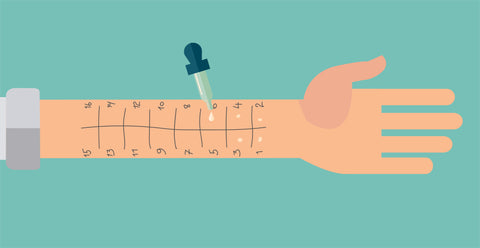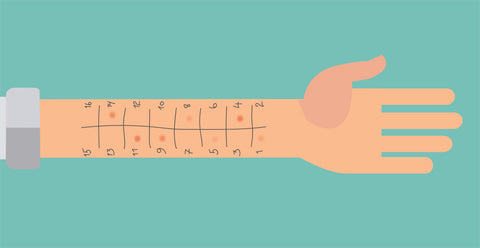Skin prick allergy testing
Are you sniffing and sneezing all the time? Do you experience skin irritations? Or problems when you eat certain foods? Would you like to find out what could be causing these symptoms? Think it might be an allergy?
Skin prick tests are one of the most common ways to diagnose what you are allergic to. Let’s take a look at how skin prick tests for allergy are done and what the results of a skin prick test can mean for you.
What is a skin prick allergy test?Skin prick tests are one of the most common diagnostic tools for people with allergy. It doesn’t mean you have skin allergy. Your skin is simply used as a canvas for the test.
Even though you might have symptoms in your eyes, nose, lung or gut, a skin prick test can still show a reaction to your triggers. And the reaction on your skin can then be measured and compared.
Skin prick tests are done when allergy is suspected. A skin prick test may help to identify the triggers, or “allergens” that could be causing your allergy symptoms. Information from a skin prick test can help your doctor develop a treatment plan for your allergy.
When should skin prick allergy tests be done?If your allergy symptoms are mild and the cause is obvious, your doctor will be able to offer advice and discuss treatment options with you. But you may be referred for a skin prick test if your allergy is more severe or it’s not clear what’s causing your symptoms. Skin prick testing usually takes place at a specialist allergy clinic. The results of skin prick testing for allergy must be analysed alongside your medical history and symptoms.
How are skin prick tests for allergy performed?
Preparation for a skin prick test
First, your skin will be prepared for the test. Usually the skin of the underside of your forearm will be used. The skin of the back can also be used, which may be a better option for small children. The doctor will mark out a grid on your skin or use a numbered tape. This allows each allergen that will be tested to have its own area on your skin.

Applying the allergens
Next, a series of allergens will be tested. A drop of each allergen to be tested and the controls will be placed on the skin. We’ll explain the use of a controls below.

The top layer of your skin under each drop is gently pricked with a lancet, so that the allergen is introduced into the skin. A skin prick test doesn’t cause bleeding. For most people skin prick testing isn’t painful, but it could feel a little uncomfortable or itchy.

What is a control?
In addition to having a spot for each allergen to be tested, you will also have a spot for a control test. A control test makes sure that the results of the skin prick test are valid. The positive control substance for a skin prick test for allergy is histamine. Histamine is one of the chemicals your body produces when you have an allergic reaction. A drop of histamine is placed on one side of the control area of the grid on your skin. A negative control test is also performed using a drop of the liquid with no allergen or histamine. Doing the control tests means your skin’s reaction to histamine and the physical act of being pricked can be compared to reactions triggered by the tested allergens.
Reading the results of a skin prick test
The skin-pricking part of the test lasts about ten minutes. Once it’s complete, you will need to wait for a further 15 to 20 minutes before the results can be analysed. The control spot will be checked to make sure the results are valid. Each spot of skin tested will be checked for a weal and flare reaction.

If there is a reaction it’ll be characterised by a small, red, itchy, bump of skin similar to a mosquito bite. Each weal and flare reaction on your skin will be measured across the longest diameter. Weals that measure 3mm or more are generally positive. Weals less than 3mm in diameter are considered negative.
If you find the weals from the skin prick test too itchy or irritating, tell the doctor or nurse. They might be able to give you something to soothe it after the result have been read, such as a corticosteroid cream. Any reaction usually fades within a few hours.
Skin prick tests produce quick results. Any reaction on your skin can be analysed within 20 minutes. The speed of skin prick testing is one advantage over blood testing for allergy. It can take up to two weeks for the results of blood tests for allergy to be available. Skin prick testing is generally well tolerated and side effects are rare.
What do skin prick test results mean?No reaction on the tested spot of skin, or a weal that is less than 3mm in diameter, means a negative skin prick test result. So, allergy to that particular allergen is very unlikely. Weals more than 3mm in diameter indicate a positive skin prick test result.
A positive skin prick test can imply which allergen or allergens might be responsible for causing your allergy symptoms. But it is possible to have a positive skin prick test result and not develop allergy symptoms when you are exposed to that allergen. This happens in about 15% of people with a positive skin prick test. This is why your skin prick test results must always be considered in relation to your medical history.
How accurate are the results for skin prick testing for allergy?The overall accuracy of skin prick tests for allergy is high. However, the accuracy can be affected by certain medications, such as antihistamines. Ask your doctor which medication you need to stop taking in the lead-up to your skin prick test.
What to do after skin prick tests for allergyKnowing what you are allergic to means you’re better equipped to manage your allergy symptoms. You’ll be able to discuss your treatment options with your doctor or allergy specialist and make decisions that are right for you.
klarify - We’re here for youWe have a wealth of further information available for you in the Allergy Know-how area of our website. Find everything you need to know about allergies in our easy-to-read, research-based articles.
Discover tips and practical solutions to help reduce the impact of allergies on your life. We make life with allergy surprisingly simple.
Thank youIf you’ve read all the way to the end of this article, thank you. And we’d love to know what you think. Have you had a skin prick test for allergy? Has knowing what you’re allergic to made a difference for you? Head over to our Facebook page or email us and share your story.
1390CCb September 2019



